07-05-2020 | Empirical Research
How is Mindfulness Linked to Negative and Positive Affect? Rumination as an Explanatory Process in a Prospective Longitudinal Study of Adolescents
Gepubliceerd in: Journal of Youth and Adolescence | Uitgave 10/2020
Log in om toegang te krijgenAbstract
Research shows greater mindfulness is associated with less negative affect and more positive affect. Fewer studies have examined the mediating psychological processes linking mindfulness to these outcomes in adolescents. This three-wave, prospective longitudinal study examines rumination—the tendency to engage in repetitive and negative self-focused thinking—as one potential explanatory process. High school students (N = 599, Mage = 16.3 years; 49% girls) completed a short-form version of the Five Facet Mindfulness Questionnaire, in addition to self-report measures of rumination and negative and positive affect three times over the course of a school year. Autoregressive, cross-lagged panel models tested reciprocal, prospective associations between mindfulness, rumination, and negative and positive affect, while accounting for prior levels of each construct, within-wave covariances, and gender and grade level. The results showed that the nonjudgment mindfulness facet (and the total mindfulness score) predicted cross-wave reductions in rumination, that in turn predicted cross-wave reductions in negative affect. No evidence for mediation was found for positive affect, or for any of the other mindfulness facets (describe, acting with awareness, and nonreactivity). This study provides suggestive evidence that individual differences in mindfulness, and in particular nonjudgmental acceptance, prospectively predict less negative affect through lower rumination.
